- Assiniboine
- Brookgold
- Brookred
- Ember
- Hardy Sand Cherry
- Italian
- Pembina
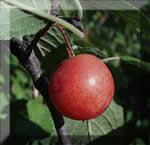 |
A seedling of the Manitoba wild plum (Prunus nigra) selected by Dr. Hansen from a lot of seed from Canada and introduced in 1908. The tree is upright, very winter hardy, productive and a powerful pollinator. Assiniboine bears reliable crops of thin red skinned plums with yellow, juicy tender flesh. Ripens in early September with beautiful egg-shaped fruit, excellent fresh from the tree, preferred for canning and highly recommended for our Montana kitchen orchards.
|
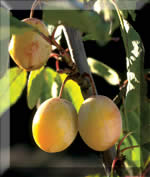 |
A recent cold-hardy plum developed at the Brooks Ag. Experiment Station, Brooks Alberta, Canada. The fruit is early, large, golden yellow and free-stone with a tender skin. The fruit ripens in late August and is rated good for cooking or eating fresh from the tree.
|
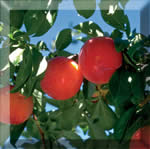 |
Another selection from Brooks Alberta, Canada. The tree is very winter hardy and vigorous. The fruit is large, dark-red and free-stone. Rated as good for eating out of hand and valuable in the kitchen.
|
 |
A very winter hardy plum variety from Saskatchewan, Canada. The fruit is large, egg-shaped, and bright orange-red skin covers a free-stone and very juicy, orange flesh. Another antique variety from Clayton Berg, Helena MT many years ago. Ember ripens late in September in the Bitterroot, rated as excellent for eating fresh and for cooking or preserves. A powerful pollinator, our Ember Mother tree always gathers a crowd.... Yummmmmm seems to describe this beautiful orange-red plum.
|
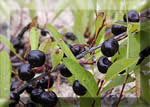 |
A gift from Clayton Berg, Helena MT in the '80s, a very winter hardy and unusual fruit. A deep purple, almost black skin covers these round, rare, unique, 1" gems. The sweet, juicy flesh also carries the beautiful purple color, ripening in mid-August. While this plant is bud grafted to Pr. Americana, it is reluctant to produce a dominant leader, preferring a tight canopy. This early season, unique treasure is highly recommended where winter extremes tolerate only the truly hardy.
|
 |
Probably originated at Milan, Italy about 1800, this is the famous old purple plum we all remember, fresh from the tree or pitted and dried or otherwise petrified. The flesh is firm, high in sugar and good flavor when season allows. Prune plums are self-fertile, requiring no pollinator, bud grafted to Prunus myrobolen, and ripen in early September. Well established and still requested in Western Montana.
|
 |
A very old antique variety and still highly recommended in the North. Pembina is a cross between Pr. Nigra X Red June by Dr. Neils Hansen, South Dakota State University, 1917. The fruit ripens in early September, large, with a beautiful deep red skin dusted with a bluish cast. The flesh is bright yellow gold, sweet and rated excellent for eating fresh and good for canning. A gift from Clayton Berg, Helena, MT in the '80s, Pembina plum is very winter hardy, productive and a favorite in our Mother Block.
|
|
- Perfection
- Pipestone
- Ptitsin9
- Ptitsin5
- S.Dakota
- Tecumseh
- Toka
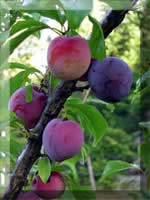 |
Released from the University of Saskatchewan in 1960, this hybrid of Prunus nigra X Prunus Salicina, is another from the collection of Clayton Berg, Helena, MT. These beautiful dark red plums are one of the first to ripen here, usually mid-August with a delicious, juicy, yellow flesh. A very winter hardy and reliable plum, Perfection may be my favorite for eating fresh from the tree and highly recommended either side of the Continental Divide.
|
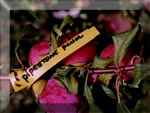 |
A seedling of Burbank Prunus salicina or Japanese Plum X Wolf and introduced by the University of Minnesota in 1942. The fruit is large with a deep red, tough skin. The flesh is sweet, juicy, golden yellow and of excellent quality for both home and commercial use. The tree is very hardy, vigorous and because of the Japanese parentage, will require a Pr. Salicina pollinator. Pipestone ripens in early September here and is one of our more reliable plums.
|
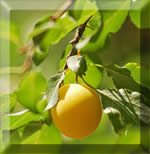 |
Ptitsin #9 - Originating in Manchuria, and introduced by the Morden, Manitoba Research Station in 1939. This fruit ripens in mid-August and is about 1.25" in diameter with a thin green-yellow skin when mature. The flesh is firm, light green, meaty, free-stone and rated as excellent for eating out of hand and preserves. The tree has a tight canopy, very winter hardy and highly recommended as a valuable and rare treat.
|
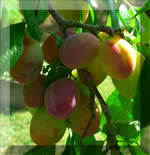 |
Ptitsin #5 - Another selection for the Manchurian plums introduced by the Canadians in 1939. A thin pale green skin with a slight blush when ripe and covers a firm, yellow-green, delicious flesh. A very powerful pollinator and rated as excellent for eating fresh or for cooking. These antique selections are ideal for sites with short seasons and winter extremes. While considered quite valuable here, they are propagated in limited numbers.
|
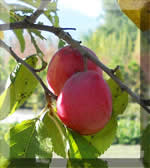 |
Released in 1949 as a joint effort with the University of South Dakota and the University of Minnesota. Neils Hansen and Charles Haralson. While the tree is very winter hardy, vigorous and productive, genetics make it a valued pollinator for many of the Japanese X American hybrids. The skin is a brightly splashed red over a pale yellow background, covering a firm, meaty, sweet flesh. We consider South Dakota treasure, one of our best fresh fruits and we recommend it highly for our Northern kitchen orchards.
|
 |
A Japanese X American plum cross introduced by N.E. Hansen in South Dakota in 1918. The fruit is medium sized, dark red skin with a bluish cast. The yellow flesh is firm, sweet and juicy. This heirloom plum is clingstone, ripens in August and produces a large crop of top quality fruit. Rated excellent fresh fruit and also valuable for sauce and jelly. The tree is exceptionally hardy, productive, and somewhat resistant to insect and disease. An excellent choice for Northern gardens and kitchen orchards.
|
 |
Another antique plum from the collection of Dr. Neils Hansen, a Prunus americana X Simonii cross, introduced in 1911. Toka is a vigorous tree with an upright canopy, may require thinning to avoid damage due to over cropping and bi-annual bearing. The bright red egg-shaped plums are excellent fresh, ripening in mid-September, Toka is also a valuable pollinator.
|
|














